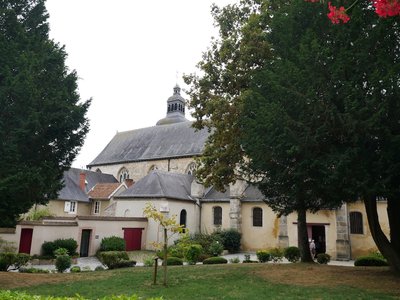Damery to Rilly-la-Montagne

Grand Est
3. Damery to Rilly-la-Montagne
Easy
4h30
24,3km
+560m
-477m
Step
Embed this item to access it offline
A stroll through the vineyards of Champagne alternating with a Luxembourg monastic foundation in the 7th century, which became famous in the Middle Ages with the monk Pérignon, inventor of Champagne.
4 points of interest

Les parcelles du vignoble champenois - Amis saint Colomban PanoramicChampagne vineyards in the Marne valley
The vineyards of the Marne Valley originate on one side, in Tours-sur-Marne, opposite the spur of Bouzy on the last mounds which limit the plain of the Champagne Pouilleuse, and on the other side, in Épernay, develops towards Paris on both banks of the river, but mainly on the right bank and with a south and south-east exposure.
It flows down all along the spread out slopes that follow the meanders of the Marne, sometimes coming closer as if to reflect in its greenish waters, sometimes moving away from them to nestle at the bottom of small picturesque cirques.
Among all the vintages, Aÿ is the grand sire and Mareuil its first lord. The Pinot noir, with its variety the golden green Pinot, gives remarkable wines. Very full-bodied, with a delicate bouquet, less fresh than those from the mountains of Reims, they bring body and finesse to the blends.
It is in Hautvillers, the cradle of champagne, with its marvellous site, that Dom Pérignon, cellarer of the abbey that has remained famous, is said to have discovered the art of champagne preparation. There, Pinot Noir is accompanied by Miller, as in Dizy, Champillon and Cumières, but beyond and on both sides of the river, there are secondary growths made exclusively from Miller grapes, whose less full-bodied and fresher wines are sought after to balance the cuvées.
The region of Epernay includes two series of vineyard slopes planted with Meunier; one stretches from Epernay to Ablois via Pierry, the other starts in Brugny-Vaudancourt and ends in Mancy, forming an arc of a circle with steep slopes.
This picturesque region produces wines that are quite full-bodied and of a particular freshness, making them sought after in blends.
Église abbatiale Saint-Pierre, devenue église paroissiale Saint-Sindulphe - Amis saint Colomban St ColumbanSaint-Pierre d'Hautvillers Abbey
Around 665, the bishop of Reims Nivard consecrated a monastery on the lands of the mountain of Reims with the agreement of King Childeric II. He will appoint the monk Berchaire to organize the community. Berchaire, originally from Aquitaine, followed his monastic training in Luxeuil. His experience of the rule of life of the Luxeuil monks will be applied from the foundation. This Luxovian rule of life was a mixture of the rules of Benedict of Nursia and Saint Colomban which complemented each other.
Berchaire left Hautvillers to found the monasteries of Montier-en-Der and Puellemontier.
The abbey prospered in spite of the vicissitudes of history: destroyed by the Normans in 882, restored then burnt down by the English in 1449, rebuilt then razed to the ground by the Huguenots in 1564. It will rise again from its ashes thanks to the donations of Catherine de Medici. It definitively ceased all activity during the Revolution. Following the revolts of the time, only the abbey church and a small part of the cloister remain. Today the monastery buildings are the property of a Champagne brand for private receptions. The most famous of the monks of this abbey is undoubtedly Dom Pérignon who invented the Champagne method for the fermentation of wine.
The abbey church of Saint-Sindulphe, a 4th century hermit whose relics were transported to the church in the 9th century, houses the relics of Saint-Nivard, Saint Helene and Dom Pérignon.
The present church dates from the 16th century and succeeds three other buildings. It is visited by many tourists from all over the world who come to thank Dom Pérignon for his famous discovery.
More information Wikipedia
L’entrée du tunnel depuis la gare de Rilly la Montagne - Amis saint Colomban HistoricalThe railway tunnel under the Montagne de Reims.
Walking on the Via Colombani, at the entrance of the forest of the Montagne de Reims, you will see a railway track below the road, you will follow it for a few hundred meters until you reach the entrance of the tunnel, then you will walk on the forest road with the tunnel under your steps until you reach the descent to Rilly-la-Montagne.
This 3450 km long tunnel was inaugurated in 1854, a few years before an accident had left about ten people dead and many injured. The aim was to link Reims to the Marne valley at Épernay.
Dynamited during the war of 1870, it was used as a shelter for official trains and then as a factory for German armaments during the war of 1939 to 1945. In 1944 the allied troops learned that V1 rockets were made in the tunnel and exhibited in Reims. About a hundred planes will pound the structure for several days but the building resists despite 6-ton bombs.
During your walk you will observe huge shell holes in the forest which in some cases have become ponds.
L’église Saint-Nicolas de Rilly-la-Montagne - Association Colomban en Brie TouristSaint-Nicolas Church in Rilly-la-Montagne.
The oldest parts of the building are located in the nave and the bell tower (12th century), as evidenced by the imposts of the large arcades. The transept and the choir have crossbows with warheads resting on Corinthian capitals dating from the 15th century; on the other hand, the filling of the bays is characteristic of the 16th century. The sacristy, built in the northeast corner, was erected in 1587 and hides part of the bays of the north chevet (Chantal Declercq). The 2nd transept and the choir are raised above the rest of the building, and present a mixture of the original 15th-century revival construction and post-war reconstruction (1920s). The nave was once preceded by a porch, probably destroyed in the 4th quarter of the 17th century (Chantal Declercq). In 1920, the war damage mentioned only concerns the covers and the stained glass windows (AD Marne, Reims. 10 R 3209). It was mainly the allied bombings of 1940-1945 and the lightning of 1948 which caused greater damage, located in the choir and the arrow, which were rebuilt. The work lasted until 1952.
Description
Leave Damery's church by turning left in front of the choir, rue Paul Douce, straight ahead at the roundabout pass in front of the town hall
- Turn right across the car park and take the Adrienne Lecouvreur alley. Turn right into the rue de Romery, then take the first vineyard path on the right, stay on the main path after 400 meters cross the crossroads. The path is oblique on the right.
- At the crossroads turn right then immediately left. At 100 meters take the track on the right up to the crossroads turn on the left, stay on the main track up to the edge of the wood turn on the right. Follow the edge of the wood to go around the forest for 2 200 meters.
- After 2,200 metres, take the path on the right which runs through the vineyard parallel to the forest as far as the Hautvillers Abbey Park, rue de l'Aubrois.
- Take the street on the right and pass coming from the church, on the left rue des Cumières then rue Bacchus, rue d'Eguisheim, rue de la Fontaine aux Frênes, go along the pond to take the path straight into the forest. Take the first road on the right until the D951.
- Cross the D951 with caution, turn left at the crossroads rue de la République, straight ahead at the junction with the D251, first track on the right, chemin de la Neuville, on the left stay on tarmac road.
- At the end of the tarred road, second track on the left in the wood, go along the Grand Étang, stay on your left at the crossroads, red and white markings, on the right on the road D71 then first track on the left, Roman road with red and white markings, on the left at the crossroads with forest road of Haute Borne, stay on the stony track, you enter the Regional Park of the Mountain of Reims.
- On the left at the crossroads, street villers-Allerand, follow the railroad then the forest road at the crossroads straight ahead to go down towards Rilly-la-Montage red and white beaconing, in the housing estate on the left, street du Pavé, cross D26, street of Reims you arrive at the church of Rilly-la-Montagne.
- Departure : St. George's Church 1 Church Square 51,480 Damery
- Arrival : Saint-Nicolas Church Place de l'Église 51,500 Rilly-la-Montagne
- Towns crossed : Grand Est
Altimetric profile
Report a problem or an error
If you have found an error on this page or if you have noticed any problems during your hike, please report them to us here:




